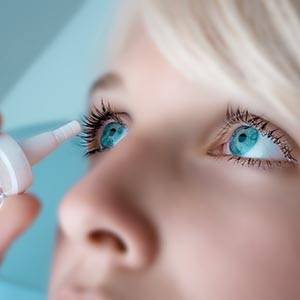Dry Eye Treatment in Grants Pass, Oregon
Dry eye occurs when you don't produce enough tears or if you produce poor-quality tears. Our eye care professionals can help.
What is Dry Eye Syndrome?
Dry Eye Syndrome, referred to as DES, is a chronic eye condition that occurs when the eyes produce an insufficient amount of tears or when the tears lack the essential balance of elements to lubricate the eye’s surface. A well-lubricated eye blocks foreign bodies or substances from irritating the eye’s surface.
Jeffery S. Pelson, OD, F.A.A.O. treats patients from all over Grants Pass, helping them achieve long-lasting relief from dry eye syndrome.


What Causes Dry Eye?
Dry eye can result due to a number of factors, including genetics, environment, the natural aging process, or prescription medications, to name a few. Dry eye syndrome is most often caused by a condition called meibomian gland dysfunction (MGD), a blockage of the tiny oil-secreting glands that line the upper and lower eyelids. Other conditions that may cause DES include blepharitis, diabetes, Sjogren’s syndrome, thyroid disease and certain autoimmune disorders.
Hormonal changes are another common cause of dry eye. In fact, women who are pregnant, breastfeeding, taking oral contraceptives, or experiencing menopause tend to experience the uncomfortable symptoms that accompany dry eye syndrome. Women over the age of 50 have double the risk of developing DES than men of the same age.
Where you live also plays a role. Dry, windy climates that strip the eyes of their natural moisture, and indoor heating systems can cause tears to evaporate prematurely. If you suffer from seasonal allergies, you also may experience dry eyes along with your other symptoms.
Common Dry Eye Symptoms
Patients with DES experience a number of symptoms that can disrupt their daily activities or cause chronic pain.
The most common signs of DES include the following:
- Blurriness
- Burning
- Dryness
- Feeling as if something is in your eye
- Irritation
- Itchy eyes
- Pain
- Red eyes
- Stinging
- Watery eyes
Those who suffer from DES often try to alleviate the pain by blinking either less or more often, rubbing their eyes, or by using over-the-counter artificial tears.
Why is blinking important? Blinking naturally moisturizes the eyes and gets rid of tiny particles that may enter the eye. Reduced blinking can increase dryness, itching, or redness, making DES symptoms even more acute.
Rubbing your eyes, especially when they’re already irritated, can intensify your symptoms. This is because the added pressure can make the pain worse. Moreover, if your hands aren’t 100% clean, you can unintentionally spread germs or bacteria into your eyes when you rub them. Rubbing the eyes can also cause tiny blood vessels to break, increasing the redness of your eyes.
Artificial tears provide temporary relief by lubricating the eyes with a specific solution. These can be quite effective at alleviating soreness and itchiness, however, excessive use isn’t recommended. Many brands include preservatives, which aren’t good for your health in the long term. Other preservative-free brands can, over time, fail to relieve the basic dry eye symptoms. Patients may find that having to continuously purchase artificial tears can become costly, and consistently using them throughout the day disrupts their daily activities.
Dry Eye Treatments
DES is typically treated with medicated eye drops, anti-inflammatory drops, or a heated compress. Occasionally, the eye doctor may recommend punctal plugs.
These are tiny devices that when inserted into the eye’s tear duct, block any drainage. This can alleviate DES symptoms by preventing moisture from draining out of the eye, ensuring that they stay inside the tear duct area. This increases the moisture level and provides longer-term relief.
Moreover, punctal plugs are not permanent and can be easily removed or replaced, making them a simple, affordable solution to alleviate symptoms.

Dry Eye Technology
Advancements in medical technology and scientific breakthroughs have made treatment for dry eye easier, offering quicker results and longer-lasting benefits. Some of the latest technologies for DES treatment include InflammaDry, LipiFlow, and TearLab.
Eye Care Group of Southern Oregon has some of the most cutting-edge and advanced technologies to quickly and effectively test for Dry Eye Syndrome. Let Jeffery S. Pelson, OD, F.A.A.O. and the talented, experienced staff help get you started on the path to real long-term relief from dry eye.
InflammaDry
Our tears contain a natural protein enzyme called matrix metalloproteinase-9, or MMP-9. Patients with Dry Eye usually have elevated levels of this protein.
The InflammaDry system measures MMP-9 levels by analyzing the tears taken from inside the lower eyelid. The entire process is fast and results are received in about 10 minutes. The disposable test is performed in the office, making it a top choice for eye doctors and DES patients.
LipiFlow
Meibomian glands are located by the eyelashes, towards the edge of the eyelid. These glands secrete oils, which lubricate the eye and keep your tears moist. When the glands become blocked, dry eye develops.
The LipiFlow system takes detailed images of the tear film, helping the eye doctor determine whether you have MGD. Then, a combination of gentle heat and light pressure is applied on both the inside and outside of the eyelid, removing the blockage and stimulating your eye’s natural moisture. The procedure takes around 12 minutes to administer and is done at the practice.
TearLab
The TearLab device measures concentration levels in human tears. This helps diagnose DES by noting any levels of tear concentration that are elevated, which signal dry eye.
TearLab is a 3-in-1 device: the test card, test pen, and countertop unit. The test card is a single-use microchip that collects a tiny sample of tear fluid in under 30 seconds. It sits inside the test pen, which analyzes and sends the data to the reader, located in the unit. The unit rests on a flat surface and displays the test results within seconds.
